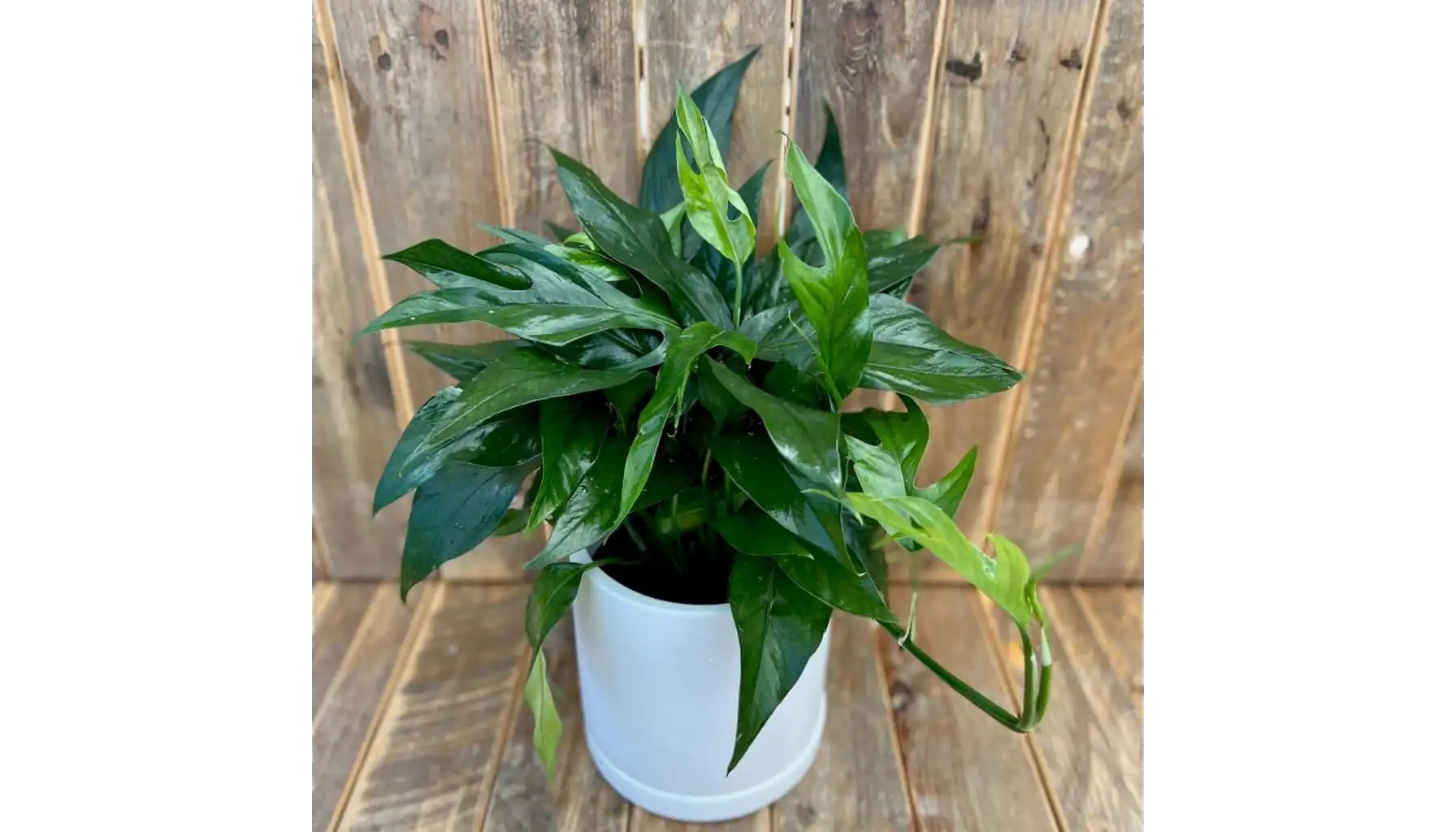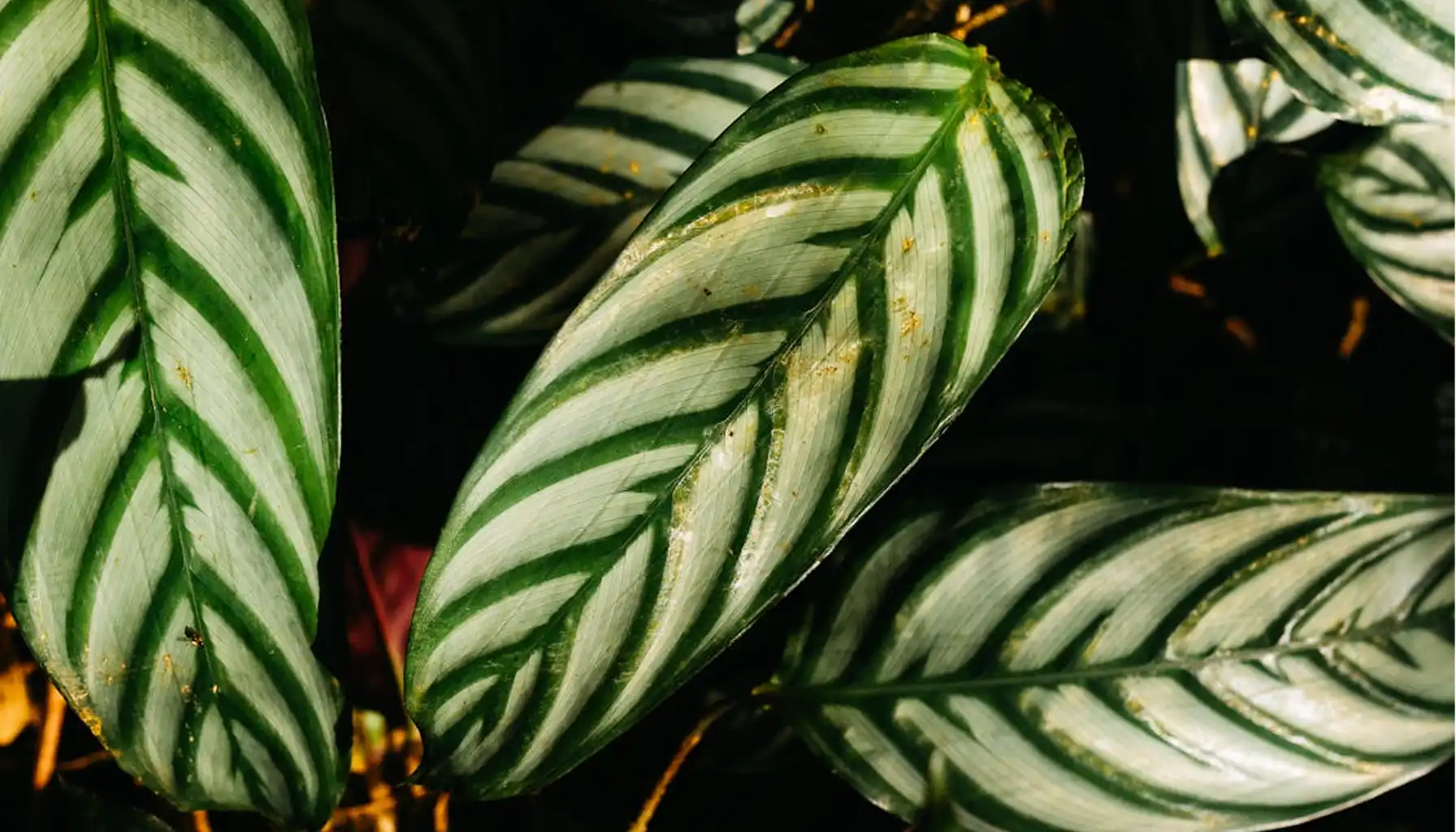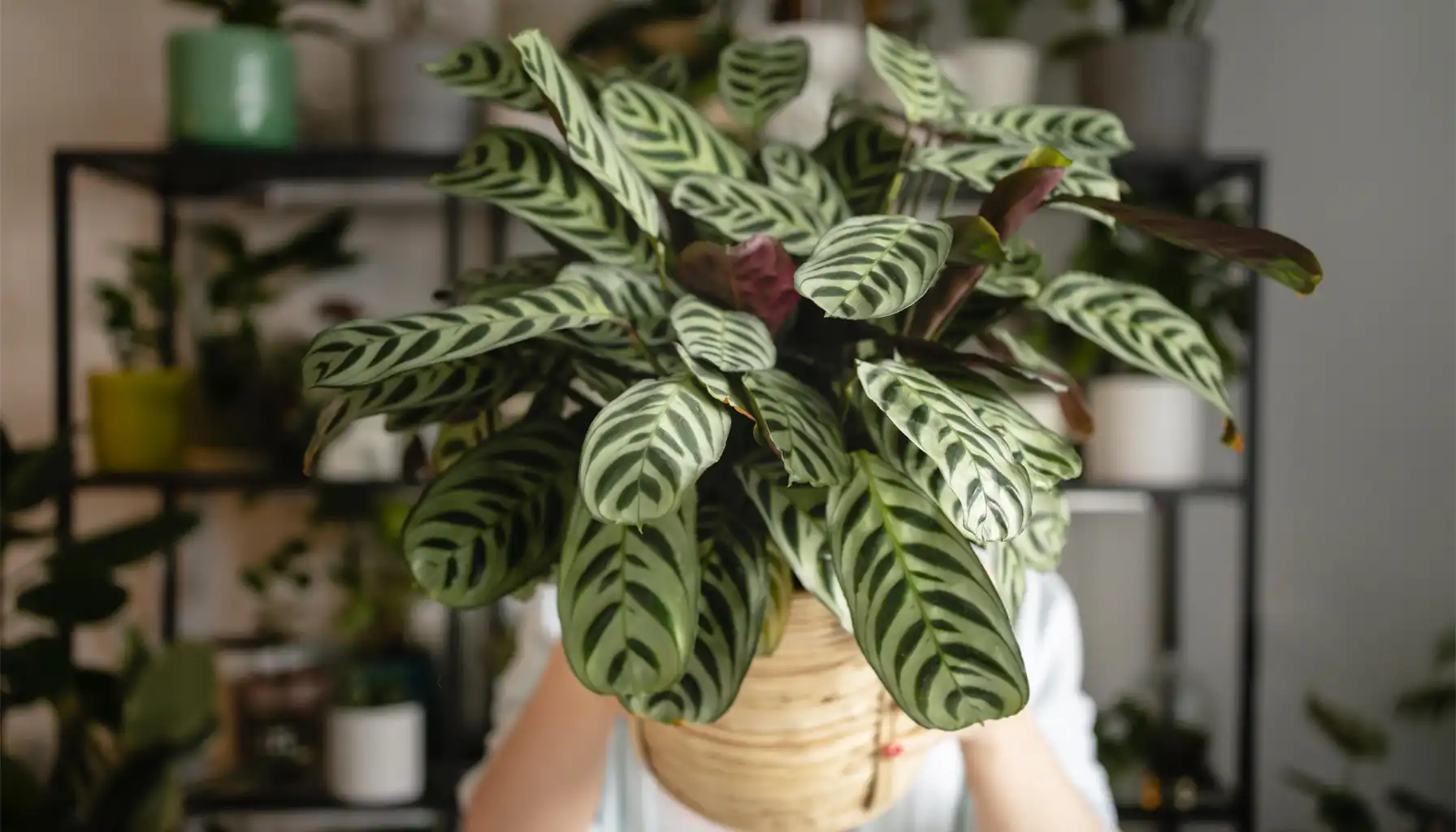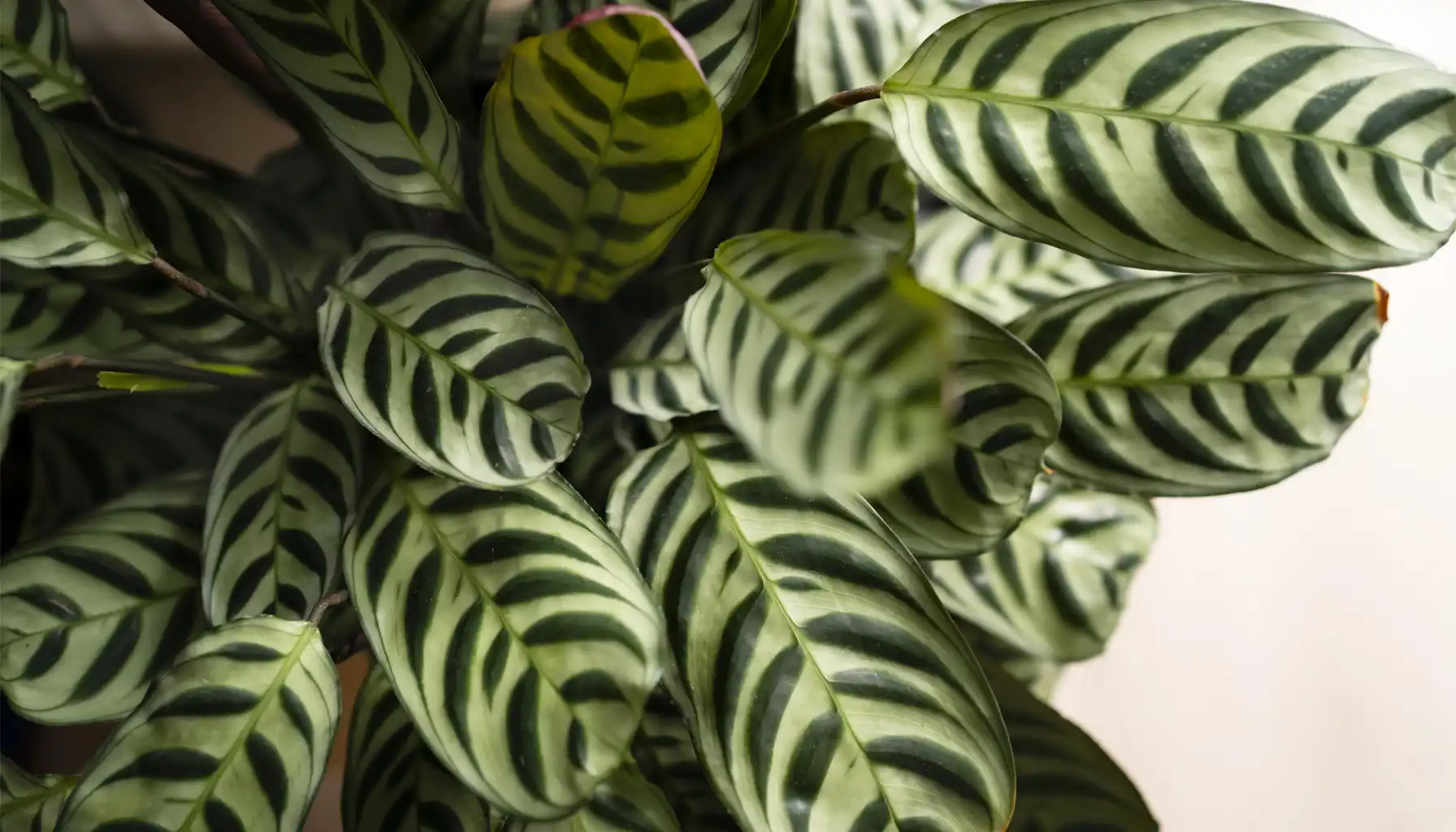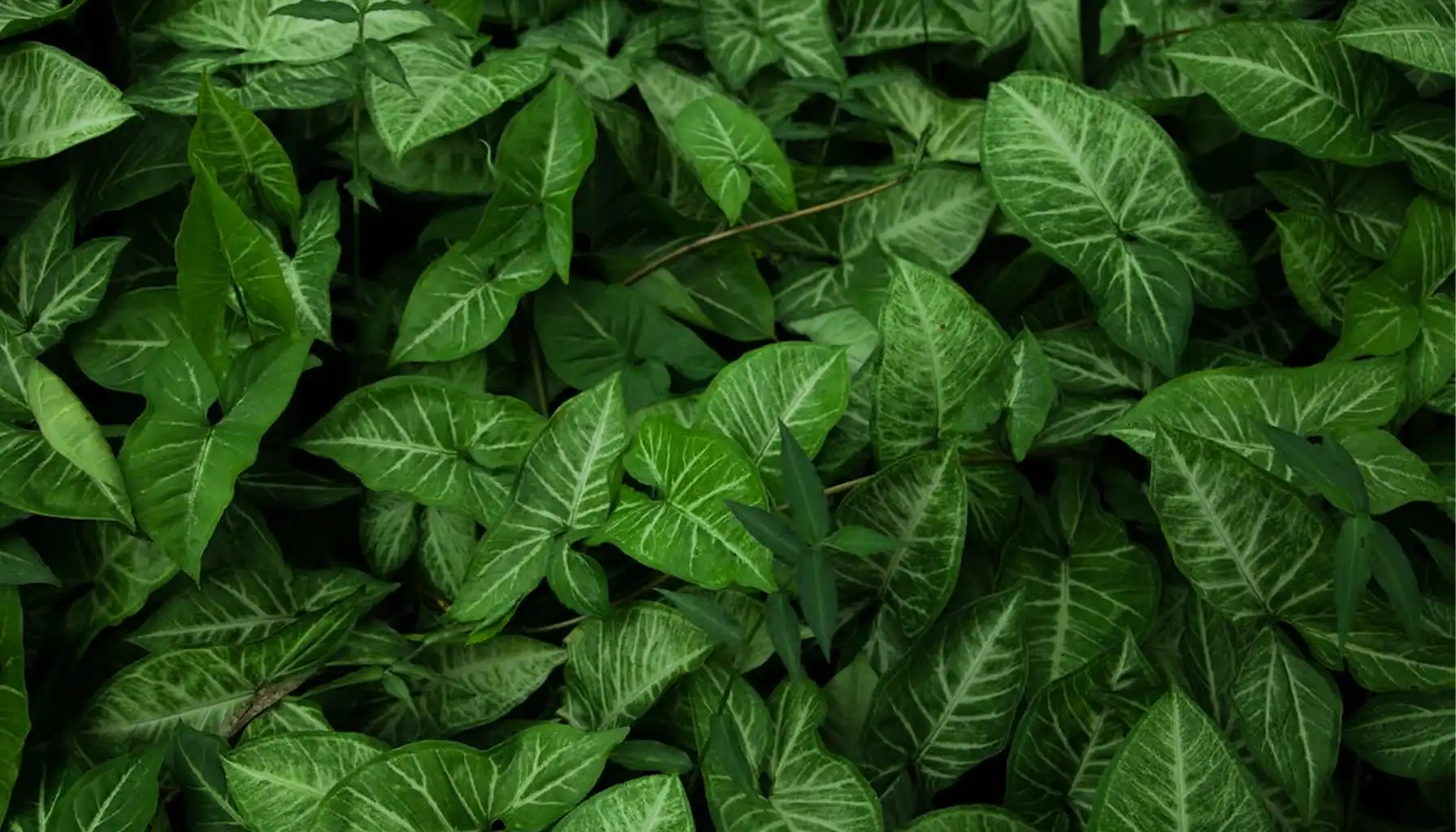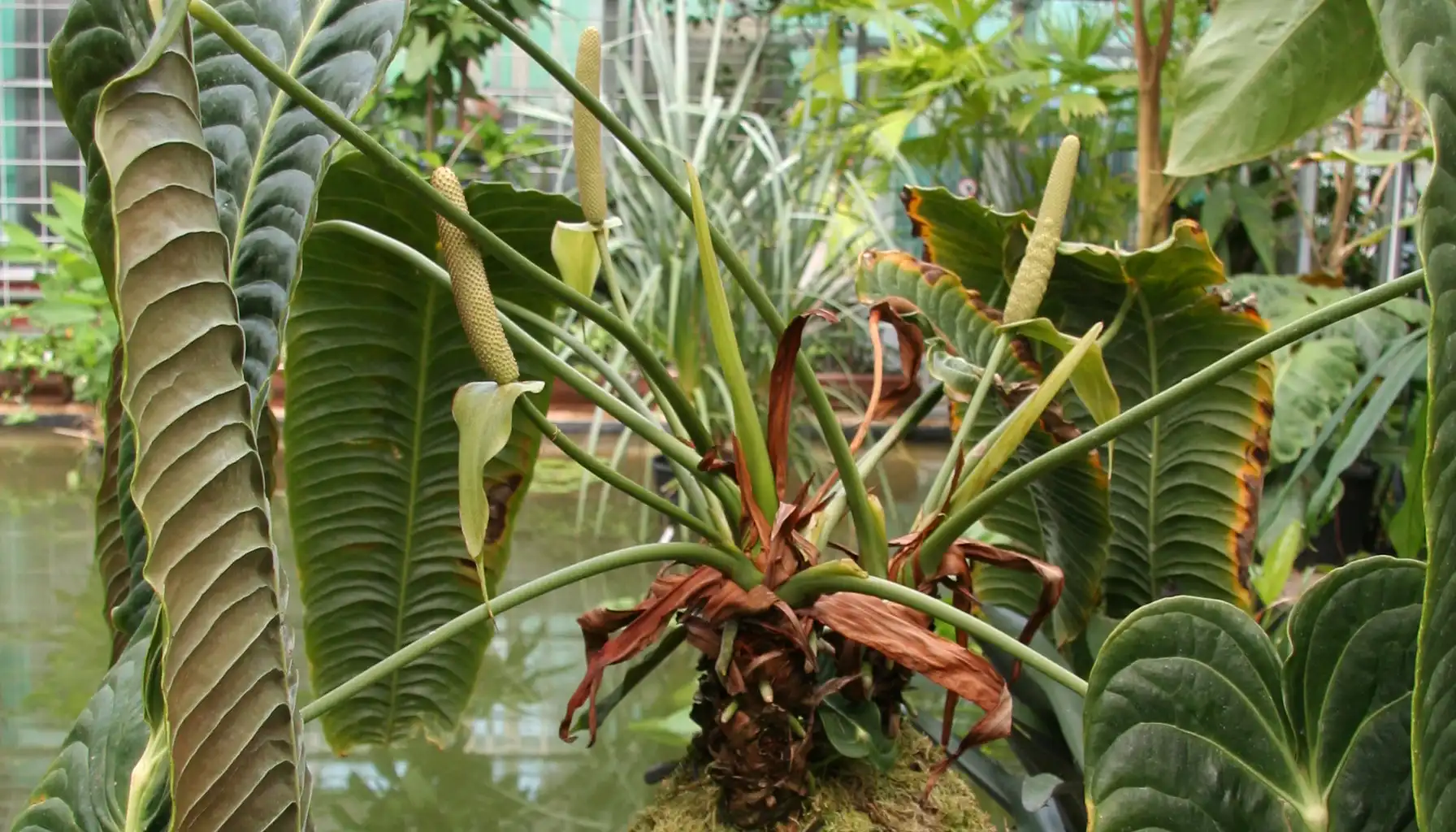Not all plants stand still, growing unnoticed. Some move actively. Maranta and Calathea, for example, will fold their leaves together every evening, just as if they were going through a ritual. Now you understand why is it called a prayer plant.
You might love them not only for that movement, but for their rich foliage, so unique in each species' variety. However, an alien-like appearance doesn’t always mean hard maintenance. This guide will ensure you a smooth, worry-free start regardless of any difficulties and show you how a reliable flower identifier can support you on the way.
Understanding What Is a Prayer Plant: Maranta vs. Calathea vs. Goeppertia
How you know those species is actually a common name for a wide group of plants. Usually it involves three main species:
Type | Botanical Name | Key Traits |
True Prayer Plant Flower | Maranta leuconeura | Leaves fold at night; bold veins (esp. red varieties) |
Calathea | Calathea spp. | Often confused with Maranta; vivid leaf patterns; wide leaves |
Goeppertia | Goeppertia spp. | Recently reclassified Calatheas; exotic markings, high contrast |
Maranta leuconeura, biologically the True one among the others, also has vivid varieties (Red, Lemon Lime, and Fishbone), popular for their unique look. But don’t you get afraid of so many varieties. While patterns differ, care needs are nearly identical. This makes them a perfect group to grow together and create incredible jungle interiors.
Is Prayer Plant Toxic to Cats?
If you share your space with active cats or nibbling dogs, your indoor garden’s safety is your first priority. And here is some great news! Unlike many dangerous tropical species, both Maranta and Calathea are classified as non-toxic to cats and dogs, so your pets will remain safe.
Yet, there are a few essentials to remember:
Ingestion may still lead to mild digestive upset, such as vomiting or loose stools.
Excessive chewing can damage the stem and stress your pet.
Some outdated or generalized sources may inaccurately list these tropical species as “mildly toxic”, but the newest data proves it wrong.
Best Practice for Pet Owners: Place the Calathea or Maranta out of direct reach or use deterrents like citrus sprays. If your pet chews leaves and shows odd behavior, consult a vet, even if the species you grow is non-toxic.
Prayer Plant Light Requirements
Prayer plant varieties thrive on bright, indirect light, but not blazing sunshine. The ideal setup is near an east- or north-facing window, where the foliage receives consistent light without exposure to harsh rays.
Changes in the aesthetic appearance might signal about poor or too bright sun, so check the following table.
Light Condition | Effect on Growth |
Bright, Indirect Light | Healthy growth, vibrant colors, proper leaf movement |
Direct Sunlight | Leaf burn, faded colors, crispy edges |
Insufficient Light | Normally prayer plant at night fold leaves, but sometimes they do it during the day, foliage becomes dull or stunted |
Pro Tip: If you’re unsure about your room’s light conditions, use the Light Meter in the AI Plant Finder. It measures light intensity in lux, helping you find the perfect spot—especially valuable in apartments or shaded homes.
Maintaining Watering Routines
Prayer plant types walk a fine line between thirst and rot. The key thing you should do is consistent moisture without overwatering.
Wait until the top inch of soil feels dry to the touch. Don’t let the soil fully dry out, but never keep it wet and heavy. Pour slowly until water drains from the bottom of the pot. Discard excess water to prevent root suffocation.
Also, make sure that you use room-temperature, filtered or dechlorinated water. Tap water that’s too hard or cold can lead to leaf spotting or tip burn. Certain symptoms might signal about unsuitable watering routines, so check them out.
Symptom | Likely Cause | Solution |
Crispy, curling leaves | Underwatering or low humidity | Water more frequently; increase moisture in air |
Prayer Plant Yellow Leaves | Overwatering or poor drainage | Let soil dry more between watering; check pot holes |
Leaf spots or browning tips | Cold or hard water | Switch to filtered or let tap water sit overnight |
Smart Tip: Use the Water Calculator in AI Plant Finder. It personalizes watering needs by analyzing your specific case in detail, pot size, indoor temperature, and humidity, so you’re not just guessing when to water but follow precise instructions.
Humidity Level: The Higher The Better
A red prayer plant evolved in the humid understory of tropical rainforests. Indoors, humidity levels below 50% can lead to dullness, brown edges, and stressed plants. Aim for 60–70% humidity, especially in winter when heating dries the air. But what if your house is not that humid usually?
Easy Humidity Boosters:
Place the pot on a tray filled with water and pebbles (ensuring the pot doesn’t sit in water).
Run a humidifier near your plant zone.
Group plants with the same needs together to create a shared humidity bubble.
Mist the leaves with lukewarm water in the morning (avoid overdoing it—wet leaves can attract fungal issues).
Feeding for Growth: Fertilize with Care
While not a heavy feeder, Lemon Lime prayer plant benefits from regular nutrients during the growing season. Its bold foliage doesn’t come from nowhere!
Type: Use a balanced, diluted liquid houseplant fertilizer (e.g., 10-10-10 or 20-20-20).
Frequency: Every 2–4 weeks from spring through early fall.
Dilution: Half-strength is best to prevent buildup and leaf burn.
Watch Out For: If you notice browning leaf tips or a white crust on the soil, you might be overdoing it. Pause feeding, flush the soil with distilled water, and resume with a weaker mix.
Temperature: Keep It Cozy and Consistent
Maranta prayer plant prefers warm, stable temperatures. Sudden cold air or heat blasts can trigger leaf stress or shock. Ideal temperature for them is around 18–27°C (65–80°F), while extremes might be harmful. Therefore, you should avoid drafts, heaters, AC units, temps <15°C (59°F).
Keep plants away from windowsills in winter, especially during nighttime chills.
Avoid placing them near air vents or radiators.
Use thermal curtains or move plants to more insulated areas during cold snaps.
Remember: Leaf yellowing or wilting can often be traced to temperature swings rather than disease or pests.
Pruning: Shape and Refresh Your Plant
A purple prayer plant doesn’t grow wildly out of control, but regular pruning is key to encouraging fuller, bushier growth and eliminating stressed leaves.
What to Prune: Remove any yellowed, browning, or damaged leaves using clean scissors or pruning shears.
How to Encourage Bushiness: Cut just above a leaf node (the place where leaves join the stem). This triggers new lateral growth.
When to Prune: Any time of year, but especially after winter or periods of stress.
Tip: Sanitize your tools before pruning to avoid spreading bacteria or fungi.
Repotting: Give Roots Room to Breathe
Prayer plant Calathea generally needs repotting every 1–2 years, usually in spring when it enters an active growing phase.
Old Pot Issues | Why Repotting Helps |
Compact or soggy soil | Fresh soil improves aeration and drainage |
Root-bound plant | Allows roots to stretch and absorb nutrients |
Accumulated fertilizer salts | New soil resets the nutrient balance |
Prayer Plant Soil Type: Use a well-draining, peat-free houseplant mix enriched with perlite or coco coir.
Pot Size: Go just one size up—too large a pot can cause overwatering problems.
How to Propagate a Prayer Plant and Extend Your Garden
Propagating prayer plant is a surprisingly easy way to multiply your tropical collection or share it with friends.
1. Division Method (best for Maranta and Calathea)
Do this during repotting.
Gently remove the plant from its pot and separate the natural clumps of stems and roots.
Replant each division in fresh soil and water well.
2. Stem Cuttings Method (especially good for Maranta)
Cut just below a leaf node.
Place the cutting in clean water.
After 2–3 weeks, when roots reach about an inch long, transplant into soil.
Pro Tip: Use the My Garden feature in the AI Plant Finder app to track the prayer plant propagation progress and set custom reminders for repotting or watering. Also you can ask a chatbot to learn more about how to propagate prayer plant.
Common Problems & Smart Solutions
Even experienced home gardeners run into prayer plant problems. What matters is how quickly you notice and adjust.
Prayer Plant Leaves Turning Yellow
Causes: Overwatering, inconsistent temperatures, low light, nutrient deficiencies.
Fix: Improve drainage, stabilize temperature, use filtered water, feed properly.
Prayer Plant Leaves Curling or Crisping
Causes: Underwatering or low humidity.
Fix: Check soil dryness, mist regularly, add pebble trays or humidifier.
Drooping or Folded Leaves (Daytime)
Causes: Low light or root stress.
Fix: Move the plant to brighter indirect light, check for root rot or compacted soil.
Simplify: Use the AI Plant Finder’s Diagnosis by Photo feature to snap a quick picture and get an instant analysis of what might be going wrong—along with actionable solutions.
While Fishbone prayer plants are not super-beginner-friendly ones, understanding how to care for a prayer plant without constant errors and second tries is possible. All you need is some courage and smart help from AI Plant Finder.
Stay patient and regular in your routines, and any difficult species will feel great at your home. Find a prayer plant near me and pot it — it is your chance to grow a true, fantastic jungle. See what you are capable of!
Related AI Plant Finder Posts
